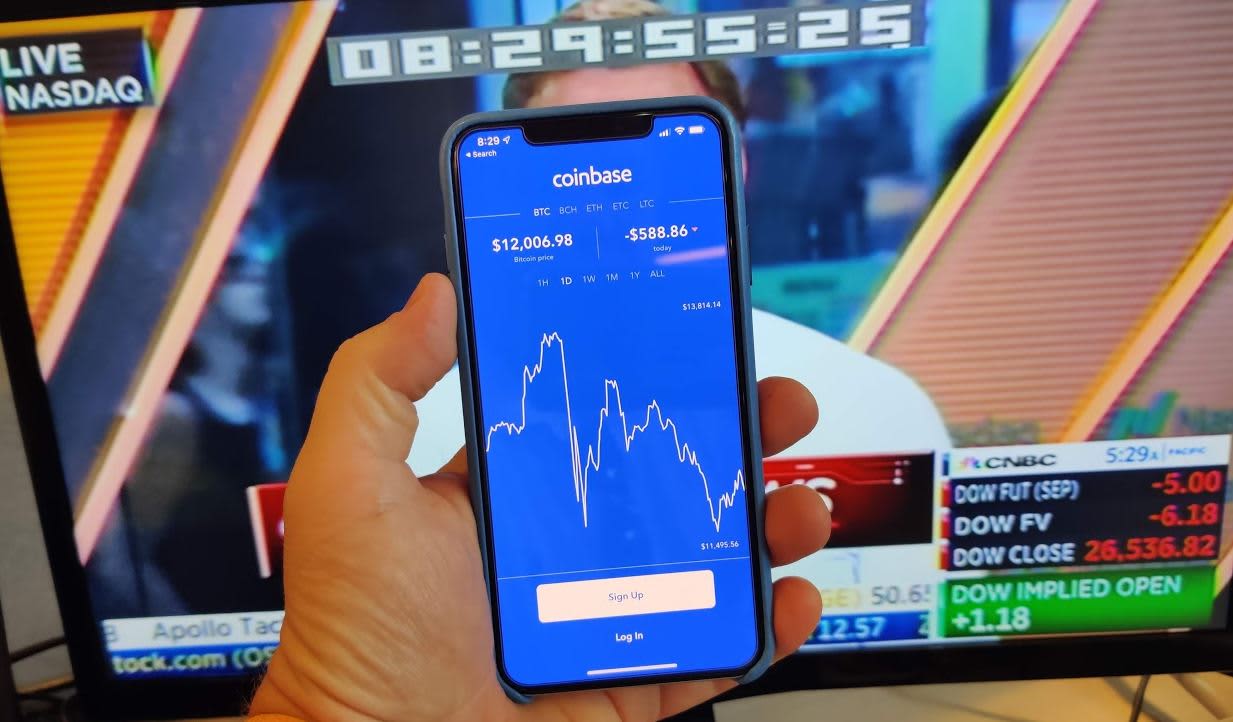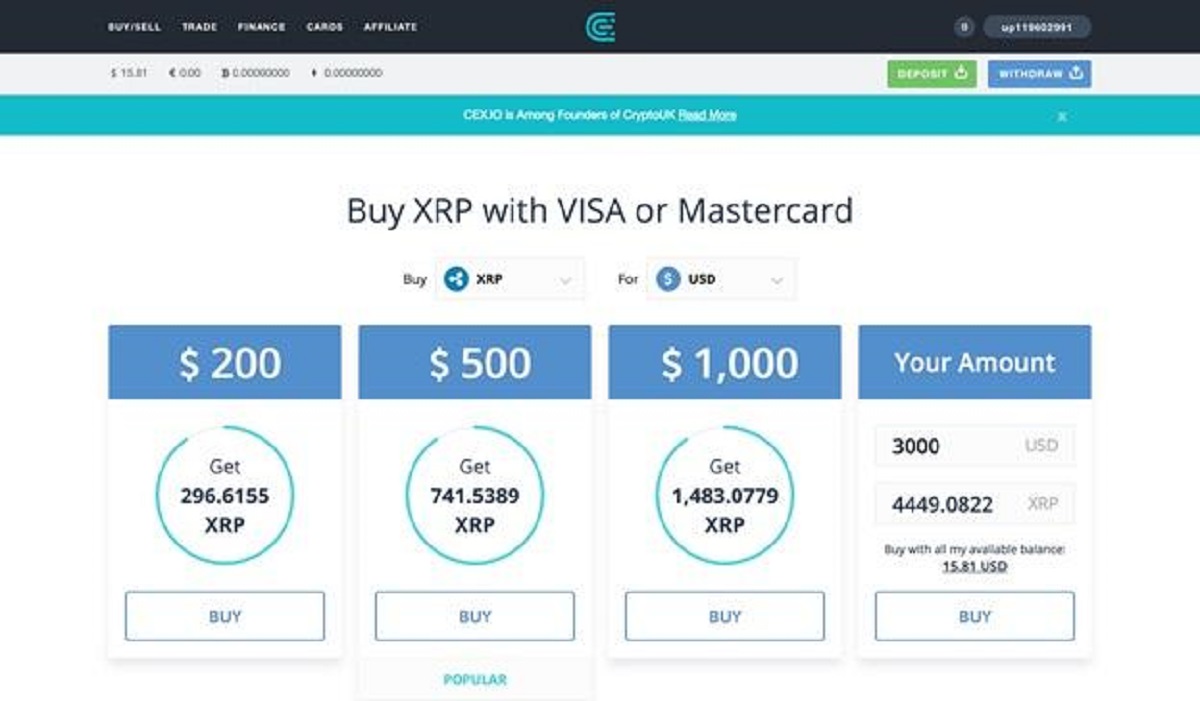Introduction
Welcome to the world of cryptocurrency! Cryptocurrency has revolutionized the financial landscape, offering individuals an alternative way to invest and transact securely online. Whether you are a seasoned investor or a newbie looking to explore the exciting realm of digital currency, this guide will provide you with the essential steps on how to buy cryptocurrency.
Cryptocurrencies, such as Bitcoin, Ethereum, and Litecoin, are decentralized digital currencies that utilize cryptography for secure transactions. Unlike traditional currencies issued by central banks, cryptocurrencies operate on a technology called blockchain, which ensures transparency and immutability.
Before you dive into buying cryptocurrency, it is crucial to understand the risks involved. The cryptocurrency market can be highly volatile, with prices fluctuating rapidly. It is essential to arm yourself with knowledge and conduct thorough research to make informed investment decisions.
In this guide, we will walk you through the process of buying cryptocurrency step by step. We will cover topics such as choosing the right cryptocurrency, setting up a cryptocurrency wallet, selecting a cryptocurrency exchange, and securing your investment. By the end of this guide, you will have the necessary knowledge to embark on your cryptocurrency investment journey confidently.
Please note that the information provided in this guide is for educational purposes only and should not be considered as financial advice. It is always wise to consult with a qualified financial professional before making any investment decisions.
Understanding Cryptocurrency
Before you start buying cryptocurrency, it is essential to have a solid understanding of what cryptocurrency is and how it works. Cryptocurrency is a digital or virtual form of currency that uses cryptography for secure financial transactions. Unlike traditional currencies issued and regulated by central authorities like governments or banks, cryptocurrencies operate on decentralized networks called blockchains.
Blockchain technology ensures transparency and security by recording and verifying every transaction made with the cryptocurrency. These transactions are stored in blocks and linked together in a chain, which is why it is called a blockchain. This decentralized nature eliminates the need for intermediaries, reduces transaction fees, and allows for faster and more secure transactions.
One of the most well-known and widely used cryptocurrencies is Bitcoin (BTC), which was introduced in 2009 by an anonymous person or group known as Satoshi Nakamoto. Bitcoin paved the way for the development of numerous other cryptocurrencies, often referred to as altcoins or alternative coins.
Each cryptocurrency has its own unique features, use cases, and communities. It’s important to research and understand the specific cryptocurrency you are interested in before investing. Some cryptocurrencies aim to serve as digital currencies for everyday transactions, while others focus on enabling smart contracts, decentralized applications, or privacy features.
Additionally, it’s important to be aware of the high volatility of cryptocurrency prices. The value of cryptocurrencies can experience significant fluctuations in short periods of time, making them attractive to traders but also posing risks for investors. It’s crucial to set realistic expectations and only invest what you can afford to lose.
In the next section, we will discuss how to choose the right cryptocurrency for your investment goals and risk tolerance.
Choosing the Right Cryptocurrency
With thousands of cryptocurrencies available in the market, it’s important to carefully choose the right cryptocurrency for your investment goals. Here are a few factors to consider when selecting a cryptocurrency:
- Market Cap: Market capitalization indicates the size and value of a cryptocurrency. Higher market cap cryptocurrencies like Bitcoin and Ethereum are generally more established and less prone to extreme volatility.
- Use Case: Each cryptocurrency serves a specific purpose. Research the use cases of different cryptocurrencies and determine if it aligns with your investment goals. For instance, if you are interested in privacy-focused transactions, cryptocurrencies like Monero or Zcash may be suitable.
- Development Team: Assess the development team behind the cryptocurrency. Look for a team with a proven track record, experience in the field, and ongoing development activities.
- Community and Adoption: A strong community and widespread adoption are indicators of a cryptocurrency’s long-term potential. Check if the cryptocurrency has an active community, supportive forums, and partnerships with established organizations.
- Risk Appetite: Understand your risk tolerance and investment strategy. Consider whether you are comfortable with highly volatile cryptocurrencies or prefer more stable options.
It’s also essential to stay updated on the latest news and developments in the cryptocurrency market. News about regulations, technological advancements, or security concerns can have a significant impact on the value of a cryptocurrency.
Remember that diversification is key. Instead of investing all your funds into a single cryptocurrency, consider spreading your investment across different cryptocurrencies to mitigate risks.
Once you have selected the right cryptocurrency(s) for your investment portfolio, it’s time to start researching and analyzing its price movements and market trends. In the next section, we will explore how to effectively research and analyze cryptocurrencies.
Researching and Analyzing
Before making any investment, it’s crucial to conduct thorough research and analysis. Here are some key steps to help you effectively research and analyze a cryptocurrency:
- Fundamental Analysis: Start by understanding the fundamental aspects of the cryptocurrency. Evaluate its underlying technology, use cases, development progress, partnerships, and the team behind it. Look for whitepapers, roadmaps, and official documentation to gain insight into the project’s vision and potential.
- Technical Analysis: Utilize technical analysis to study the price charts and identify trends and patterns. You can use tools like moving averages, Bollinger Bands, and Relative Strength Index (RSI) to analyze price movements and make informed decisions.
- Market Sentiment: Monitor social media platforms, news outlets, and discussion forums to gauge the sentiment surrounding the cryptocurrency. Positive news and community engagement can potentially contribute to price appreciation, while negative sentiment may result in price declines.
- Competitive Analysis: Compare the cryptocurrency you are interested in with its competitors. Assess factors such as market share, technological advancements, and community support. This will help you understand the cryptocurrency’s competitive edge and potential for growth.
- Industry Analysis: Consider the broader industry trends and developments. Stay updated on regulatory changes, adoption by major institutions, and innovations in blockchain technology. These factors can significantly impact the overall cryptocurrency market and individual cryptocurrencies.
Keep in mind that investing in cryptocurrency carries risks, and no analysis can guarantee future performance. It’s essential to maintain a balanced perspective and make decisions based on a combination of factors.
In the next sections, we will guide you through the practical steps of setting up a cryptocurrency wallet, selecting a cryptocurrency exchange, and executing your first buy order.
Setting Up a Cryptocurrency Wallet
A cryptocurrency wallet is a digital application or device that allows you to securely store, send, and receive your cryptocurrencies. Here are the steps to set up a cryptocurrency wallet:
- Choose a Wallet Type: There are different types of wallets, including software wallets, hardware wallets, and online wallets. Each has its own advantages and security measures. Software wallets can be installed on your computer or mobile device, while hardware wallets are physical devices that offer added security. Online wallets are cloud-based wallets accessible from any internet-connected device.
- Research and Select a Wallet: Research the available wallet options and consider factors such as security features, ease of use, multi-currency support, and community reputation. Popular software wallets include Exodus, Electrum, and MyEtherWallet, while hardware wallets like Ledger and Trezor offer enhanced security.
- Download and Install: If you choose a software wallet, visit the official website of the wallet provider and download the appropriate version for your operating system. Follow the installation instructions to set up the wallet on your device.
- Create a New Wallet: Once the wallet is installed, you will typically be prompted to create a new wallet. This involves generating a unique and secure password or seed phrase. It’s crucial to write down your seed phrase and store it in a safe place, as it can be used to recover your wallet if your device is lost or damaged.
- Secure Your Wallet: Set up additional security measures, such as enabling two-factor authentication (2FA) and using a strong password. Be cautious of phishing attempts and only access your wallet through the official website or application.
- Receive and Send Cryptocurrency: Your wallet will provide you with a unique address for each cryptocurrency. You can share this address with others to receive funds. To send cryptocurrency, enter the recipient’s address and the amount you wish to send, and confirm the transaction.
It’s important to note that while a wallet provides a secure storage solution, it does not guarantee the security of your funds if your device is compromised. Use caution when installing software or providing your wallet information to third-party services.
Once you have set up your cryptocurrency wallet, the next step is to select a cryptocurrency exchange to buy your desired cryptocurrency. We will discuss this in the following section.
Selecting a Cryptocurrency Exchange
A cryptocurrency exchange is an online platform where you can buy, sell, and trade cryptocurrencies. When selecting a cryptocurrency exchange, consider the following factors:
- Reputation and Security: Choose a reputable exchange with a track record of security and user trust. Look for exchanges that have implemented robust security measures like two-factor authentication (2FA), cold storage, and encryption to protect your funds.
- Liquidity: Liquidity refers to the ability to buy or sell an asset quickly without significantly affecting its price. Opt for exchanges with high trading volumes and a wide selection of cryptocurrencies to ensure you can execute your trades efficiently.
- Supported Cryptocurrencies: Check if the exchange supports the specific cryptocurrencies you want to buy. Some exchanges have a limited range of cryptocurrencies available, while others offer a broader selection.
- Fees and Trading Options: Examine the fee structure of the exchange, including deposit, withdrawal, and trading fees. Compare the fees with other exchanges to ensure you are getting competitive rates. Additionally, consider the trading options available, such as spot trading, margin trading, or futures trading.
- User-Friendly Interface: Look for an exchange that offers an intuitive and user-friendly interface. An easy-to-use platform will make the buying process smoother, especially for beginners.
- Regulation and Compliance: Check if the exchange operates within a regulated framework and follows know-your-customer (KYC) and anti-money laundering (AML) practices. Regulation adds an extra layer of security and legitimacy to the exchange.
Some popular cryptocurrency exchanges that meet these criteria include Coinbase, Binance, Kraken, and Bitstamp. However, it’s always wise to research and compare multiple exchanges before making a decision.
Once you have selected a suitable cryptocurrency exchange, the next step is to register and verify your account. We will guide you through this process in the following section.
Registering and Verifying Your Account
To start trading on a cryptocurrency exchange, you will need to register an account and complete the verification process. Here are the general steps to register and verify your account:
- Visit the Exchange’s Website: Go to the official website of the chosen cryptocurrency exchange.
- Create an Account: Click on the “Sign Up” or “Register” button to create a new account. You will be prompted to provide your email address, password, and possibly your full name.
- Verify Your Email: Check your email inbox for a verification message from the exchange. Click on the verification link provided to confirm your email address.
- Complete KYC Verification: Most exchanges require you to complete a Know Your Customer (KYC) verification process to comply with legal and regulatory requirements. This process typically involves submitting identification documents such as a passport or driver’s license, as well as proof of address like a utility bill or bank statement. Follow the instructions provided on the exchange’s website to upload the required documents securely.
- Wait for Verification: The verification process may take some time, ranging from minutes to several days, depending on the exchange. During this time, be patient and avoid making multiple registration attempts.
- Verify 2FA: Consider enabling two-factor authentication (2FA) for an added layer of security. This typically involves linking your exchange account to an authentication app like Google Authenticator, which generates a unique verification code for each login attempt.
It’s important to note that each exchange may have slightly different registration and verification procedures. Be sure to read and follow the specific instructions provided by the exchange you have chosen.
Once your account is registered and verified, you can proceed to deposit funds into your account. The next section will guide you through this process.
Depositing Funds into Your Account
After successfully registering and verifying your account on the chosen cryptocurrency exchange, the next step is to deposit funds into your account. Here’s how to deposit funds into your cryptocurrency exchange account:
- Login to Your Account: Visit the exchange’s website and login to your account using the credentials you created during the registration process.
- Locate the Deposit Option: Look for a section or tab on the exchange’s website that says “Deposit” or “Funds.” This section will provide you with instructions on how to deposit funds.
- Select the Cryptocurrency: Choose the cryptocurrency you want to deposit into your account. Ensure that you select the correct cryptocurrency from the available options, as each cryptocurrency has its unique wallet address.
- Generate a Deposit Address: The exchange will provide you with a unique deposit address for the selected cryptocurrency. This address is where you will send your funds from your wallet or another exchange.
- Initiate the Deposit: Open your cryptocurrency wallet or the interface of another exchange where you hold the funds. Enter the deposit address generated by the exchange and the amount you want to deposit. Follow the instructions to complete the transaction and initiate the deposit.
- Wait for Confirmation: Cryptocurrency transactions typically require confirmations on the blockchain network. The number of confirmations required may vary depending on the exchange and the specific cryptocurrency. Wait for the required number of confirmations before your funds become available in your exchange account.
It’s important to double-check the deposit address before initiating the transaction. Sending funds to the wrong address may result in a loss of funds.
Different exchanges may have different deposit methods available, such as bank transfers or credit/debit card payments. Be sure to review the options provided by the exchange and choose the method that is most convenient and secure for you.
Once your funds are successfully deposited into your exchange account, you can proceed to place a buy order for your desired cryptocurrency. The next section will guide you through this process.
Placing Your Buy Order
Now that you have funds in your cryptocurrency exchange account, you can proceed to place a buy order for your desired cryptocurrency. Here’s how to place a buy order on a cryptocurrency exchange:
- Login to Your Account: Visit the exchange’s website and login using your credentials.
- Locate the Trading Section: Look for a section or tab on the exchange’s website that says “Trade” or “Exchange.” This section will provide you with access to the trading interface.
- Select the Trading Pair: Choose the trading pair you want to use. Typically, you will be trading the cryptocurrency you deposited for the cryptocurrency you want to buy. For example, if you deposited Bitcoin and want to buy Ethereum, you would select the BTC/ETH trading pair.
- Choose the Type of Order: There are different types of orders, including market orders and limit orders. A market order will buy the cryptocurrency at the current market price, while a limit order allows you to set a specific price at which you want to buy the cryptocurrency. Select the appropriate order type based on your preferences.
- Enter the Order Details: Enter the amount of cryptocurrency you want to buy and review the order details. Take note of any applicable fees or trading restrictions.
- Place the Order: Once you are satisfied with the order details, click on the “Place Order” or “Buy” button to execute the buy order. The exchange will match your order with a corresponding sell order from another user or liquidity provider.
- Monitor the Order and Confirm Execution: After placing the order, monitor your account to ensure that it is executed successfully. Once the buy order is filled, the cryptocurrency you purchased will appear in your exchange account balance.
It’s important to note that cryptocurrency prices can be volatile, so the execution price of your order may differ slightly from the displayed price at the time of order placement. Additionally, each exchange may have different interfaces and order placement procedures, so be sure to familiarize yourself with the specific features and workflow of the exchange you are using.
Congratulations! You have successfully placed your buy order and acquired your desired cryptocurrency. In the next section, we will discuss the importance of securing your cryptocurrency holdings.
Securing Your Cryptocurrency
After purchasing cryptocurrency, it is crucial to take the necessary steps to secure your holdings. Here are some key measures to ensure the safety of your cryptocurrency investments:
- Use a Secure Wallet: Transfer your purchased cryptocurrency from the exchange to a secure wallet that you control. Hardware wallets, such as Ledger or Trezor, offer enhanced security by storing your private keys offline.
- Backup Your Wallet: Create a backup of your wallet’s seed phrase or private keys and store it securely in multiple locations. This backup will allow you to recover your wallet in case of loss, theft, or damage.
- Enable Two-Factor Authentication (2FA): Activate 2FA on your wallet and exchange accounts to add an extra layer of protection. 2FA requires a second verification step, usually a code generated on a separate device, to log in or authorize transactions.
- Keep Software Up to Date: Ensure that your wallet and device software is regularly updated with the latest security patches. This helps protect against known vulnerabilities and exploits.
- Be Cautious of Phishing Attempts: Be vigilant against phishing attempts, which are fraudulent attempts to obtain your wallet or account information. Always ensure that you are visiting legitimate websites and do not share your sensitive information with anyone.
- Use Strong Passwords: Create strong, unique passwords for your wallet and exchange accounts. Consider using a password manager to securely store and generate complex passwords.
- Diversify Your Holdings: Consider diversifying your cryptocurrency holdings across different wallets or hardware devices. This spreads the risk and mitigates potential losses in case of a security breach.
It’s important to understand that securing your cryptocurrency is a continuous effort. Stay updated on the latest security practices and be proactive in protecting your investments.
By following these security measures, you can significantly reduce the risk of unauthorized access or loss of your cryptocurrency. In the next section, we will discuss how to keep track of your investment.
Keeping Track of Your Investment
Once you have bought cryptocurrency and secured your holdings, it is important to keep track of your investment to monitor its performance. Here are some key strategies to help you effectively track your cryptocurrency investment:
- Portfolio Management Tools: Utilize portfolio management tools and cryptocurrency tracking platforms to monitor the value of your cryptocurrency holdings. These tools provide real-time price updates, portfolio performance analysis, and customizable alerts.
- Set Investment Goals: Clearly define your investment goals, whether they are short-term or long-term. This will help you stay focused and make informed decisions based on your objectives.
- Monitor Market Trends: Stay informed about market trends, news, and events that can impact cryptocurrency prices. Follow reputable sources, industry blogs, and social media channels to keep up with the latest developments.
- Track Profit and Loss: Regularly review and analyze your profit and loss statements to assess the performance of your investments. This will give you insights into your gains, losses, and overall return on investment.
- Implement Risk Management Strategies: Consider implementing risk management strategies, such as setting stop-loss orders or taking profits at predefined levels. This helps protect your capital and manage the inherent volatility of the cryptocurrency market.
- Stay Disciplined: Stick to your investment strategy and avoid making impulsive decisions based on short-term market fluctuations. Emotions and market hype can often cloud judgment, so maintaining discipline is crucial.
- Keep Records: Maintain proper records of your transactions, including buy orders, sell orders, and any transfers between wallets. Accurate record-keeping simplifies tax reporting and helps you stay organized.
Additionally, it’s important to periodically review and reassess your investment strategy. As the cryptocurrency market evolves, you may need to adjust your portfolio composition or investment goals accordingly.
By implementing these strategies and staying informed, you can effectively track your cryptocurrency investment and make more informed decisions based on market trends and your own financial goals.
Conclusion
Congratulations! You have reached the end of this guide on how to buy cryptocurrency. We have covered essential steps and considerations to help you navigate the world of cryptocurrency investment. Here’s a quick recap of the key points:
- Understand the basics of cryptocurrency and how it works.
- Choose the right cryptocurrency based on your investment goals and risk tolerance.
- Thoroughly research and analyze the cryptocurrency you are interested in.
- Set up a secure cryptocurrency wallet to store your funds.
- Select a reputable cryptocurrency exchange to buy and trade cryptocurrencies.
- Register and verify your account on the chosen exchange.
- Deposit funds into your exchange account to fund your purchases.
- Place a buy order for your desired cryptocurrency.
- Secure your cryptocurrency holdings to safeguard against potential threats.
- Keep track of your investment and monitor its performance over time.
It’s important to note that investing in cryptocurrency involves risks and market volatility. It’s always advisable to stay informed, conduct thorough research, and consult with a qualified financial professional before making any investment decisions.
By following the steps outlined in this guide and staying proactive in your investment journey, you can begin your foray into the world of cryptocurrency with confidence. Remember to stay disciplined, manage risks, and regularly reassess your investment strategy as the market evolves.
Best of luck on your cryptocurrency investment journey!

























